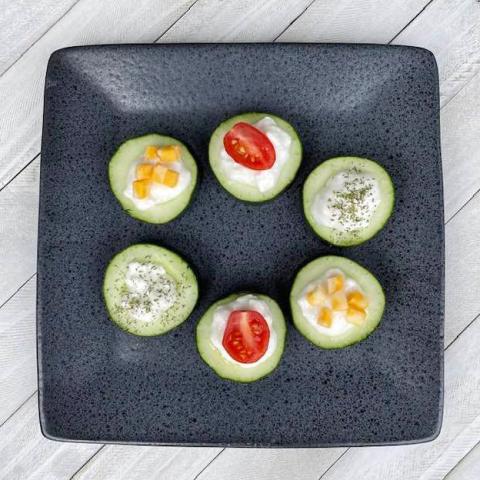
Most Americans aged 2 and older do not eat the recommended amounts of vegetables. Vegetables provide vitamins and minerals and most are low in calories and fat, so it is important to add more vegetables to your meals and snacks. Try to vary your veggies and eat the colors of the rainbow for more nutrients.
5 Ways for Children to Eat More Veggies
- Add spinach to a smoothie.
- Dip raw vegetables like broccoli, carrots, tomatoes, bell peppers or cauliflower in hummus, yogurt-based dip, or another low-fat dip. Raw vegetables are considered choking hazards for young children. Make raw vegetables safe by chopping finely or cutting into thin strips before serving them.
- Make mini pizzas by using whole-wheat English muffins as the crust and top with pizza sauce, low-fat mozzarella cheese, and chopped veggies.
- Create bugs on a log by choosing celery, cucumber, or carrot sticks as the log and top with peanut butter or another type of nut butter, and raisins or cranberries for the bugs.
- Let children help with food prep, based on their age and skills, and they are more likely to eat foods they normally do not like.

Photo by Marusa Jonas
Shamrocks and Gold Smoothie
Yield: 4 servings
Ingredients:
- ½ cup fresh spinach
- ⅔ cup 100% apple juice
- 2 cups frozen pineapple chunks, no sugar added
- 1 cup low-fat vanilla yogurt
- 1 banana, gently rubbed under cold running water
Directions:
- Wash hands with soap and water.
- Gently wash spinach under cold running water. If spinach is marked "pre-washed" or "ready-to-eat", use the spinach without further washing.
- Place the apple juice and spinach leaves into a blender. Blend well.
- Add remaining ingredients to the blender. Blend until smooth.
- Store leftovers in a sealed container in the refrigerator for up to four days.
Nutrition Information:
- Serving Size (1/4 of recipe):
- Calories 140
- Total Fat 1g
- Saturated Fat 0.5g
- Cholesterol 5mg
- Sodium 45mg
- Total Carbohydrates 30g
- Fiber 2g
- Total Sugars 23g, includes 4g Added Sugars
- Protein 4g
- Vitamin D 0%
- Calcium 10%
- Iron 8%
- Potassium 8%
Nutrition Software Used:
ESHA Food Processor
Sources:
2020-2025 Dietary Guidelines for Americans. U.S. Department of Health and Human Services and U.S. Department of Agriculture.
MyPlate - Kids. USDA Center for Nutrition Policy and Promotion.
This newsletter was reviewed and updated in 2023.
Feedback Form
Feedback Form
If you do not see the article, please scroll up the page.
Our goal is to help parents and caregivers prepare healthy meals and snacks by sharing recipes, tips and ideas that are geared for children ages 2 to 5.








